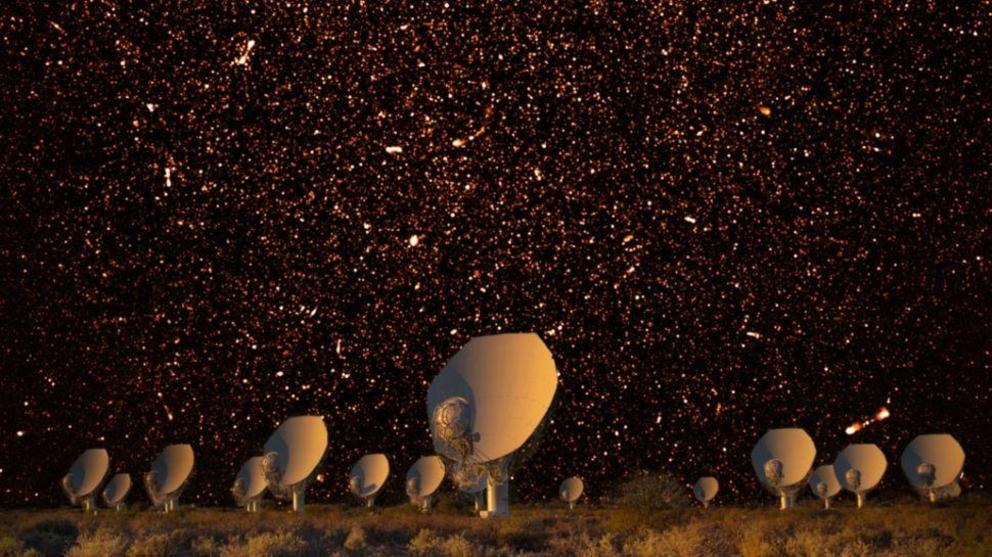Search for alien life just got 1,000 times bigger after new telescope joins the hunt
Astronomers searching for radio signals that could be signs of extraterrestrial life have just gained access to South Africa's MeerKAT telescope.

A pair of dishes from the MeerKAT telescope in South Africa. The night sky has been overlaid with radio bubbles observed by the telescope. (Image credit: South Africa Radio Astronomy Observatory (SARAO))
One of the world's largest telescopes has just joined the hunt for signs of alien life elsewhere in the cosmos.
Since 2016, the Breakthrough Listen project has been quietly using radio telescopes to listen for unusual radio signals, or technosignatures, from potential advanced extraterrestrial civilizations within the Milky Way. The project, launched in part by the late Stephen Hawking and funded by Israeli entrepreneur Yuri Milner, already uses the Green Bank Telescope (GBT) in West Virginia in the United States and the Parkes Telescope in New South Wales, Australia, as well as other radio telescopes from across the globe, to scan nearby stars. But now, the MeerKAT Telescope — an array of 64 individual dishes in South Africa, and currently the largest radio telescope in the Southern Hemisphere — has joined the party.
After more than two years of integrating their programs into the MeerKAT system, Breakthrough Listen scientists have finally started using data collected by the array of dishes to look for unusual signals from nearby stars, according to a statement (opens in new tab) released Dec. 1.
The inclusion of MeerKAT will "expand the number of targets searched by a factor of 1,000," Breakthrough Listen representatives wrote in the statement. This will greatly increase the chances of detecting a technosignature, if there are any out there to be found, they added.
MeerKAT drastically improves the number of targets that Breakthrough Listen can analyze because its dishes can lock onto up to 64 different targets at once, while other telescopes can only focus on one at a time.
"MeerKAT can see an area of the sky 50 times bigger than the GBT can view at once," Andrew Siemion (opens in new tab), principal investigator of Breakthrough Listen and director of the University of California Berkeley's Search for Extraterrestrial Intelligence (SETI) Research Center, said in the statement. "Such a large field of view typically contains many stars that are interesting technosignature targets."

The MeerKAT dishes with some of the radio signals they have detected superimposed onto the sky. (Image credit: South Africa Radio Astronomy Observatory (SARAO))
Breakthrough Listen will access a continuous datastream from MeerKAT without interfering with scheduled astronomical research. Instead, data collected from other studies will be fed into a supercomputer, which uses a special algorithm to scan signals that it does not recognize as coming from known cosmic phenomena such as pulsars, stellar flares or supernovas. When a strange signal is detected, a researcher can then analyze the signal.
Using MeerKAT, Breakthrough Listen will be able to scan more than 1 million stars during the next two years, which is "very exciting," Cherry Ng (opens in new tab), an astrophysicist at the University of Toronto and a project scientist at Breakthrough Listen, said in the statement.
One of the first stars that will investigated in more detail by MeerKAT and Breakthrough Listen will be Proxima Centauri, the nearest star to our solar system, which has two exoplanets that lie within the star's habitable zone, researchers said.
In June, Chinese astronomers using the enormous "Sky Eye" telescope in Guizhou, China — the largest radio telescope on Earth — announced that they had detected a possible alien signal. But this was quickly debunked by one of the study authors who revealed the signal was almost definitely human radio interference.
Video can be accessed at source link below
